Fluffy, wholesome, homemade whole wheat bagels – is there anything better? Especially when they’re made with the Poolish method. This simple pre-ferment adds crazy amounts of rich flavor and the dreamiest texture to your bagel game. We’re talking next-level goodness here, folks.
If “poolish” sounds super chef-y and complicated, have no fear. It’s just a mixture of flour, water, and yeast that bubbles away before getting incorporated into the dough. Almost no active work required on your part. But SO much added flavor and rise power!
I’m obsessed with how the tangy, wheaty notes of the poolish prevent these bagels from being dense and instead make them perfectly soft and chewy. And skipping the oil means you get all that indulgent quality while keeping things nice and wholesome.
Whether you’re a total bagel newbie or seasoned pro, mixing up a poolish takes things up a notch but with barely any effort. I can’t wait to share my simple secrets for achieving bakery-worthy whole wheat bagels right from your home kitchen! This is a game-changing technique.
Contents
- 1 Why You Will Love This Poolish Method Whole Wheat Bagels Recipe
- 2 (Poolish Method) Whole Wheat Bagels Ingredients and Equipment
- 3 (Poolish Method) Whole Wheat Bagels Instructions
- 4 (Poolish Method) Whole Wheat Bagels Serving Suggestions
- 5 (Poolish Method) Whole Wheat Bagels Cooking Tips and Tricks
- 6 (Poolish Method) Whole Wheat Bagels Storage and Shelf Life
- 7 Frequently Asked Questions
Why You Will Love This Poolish Method Whole Wheat Bagels Recipe
Artisanal Excellence: Our bagels are made using the Poolish method, a technique that involves creating a pre-ferment to enhance flavor and texture. This extra step might take a bit longer, but the end result is worth every moment. The depth of flavor and the chewy, satisfying texture will transport you to your favorite bakery.
Nutrient-Rich Whole Wheat: These bagels aren’t just about great taste; they’re also about wholesome ingredients. We’ve crafted them using whole wheat flour, ensuring you get a healthy dose of fiber, vitamins, and minerals. It’s a guilt-free indulgence that nourishes your body.
Expertly Crafted Poolish: We’ve taken the time to explain the poolish method in detail because we believe in sharing the magic of baking science. By allowing the poolish to develop its complex flavors over time, we’ve unlocked a depth of taste that’s hard to achieve through ordinary methods.
Customizable Creations: Our recipe offers a solid foundation, but it’s also a canvas for creativity. Whether you want to add seeds, spices, or even a hint of sweetness, these bagels can adapt to your preferences. The possibilities are as endless as your imagination.

(Poolish Method) Whole Wheat Bagels Ingredients and Equipment
| Ingredients | Equipment |
Poolish
Dough
Bagel Boiling Water
|
|
(Poolish Method) Whole Wheat Bagels Instructions
|
|
|
|
|
|
|
|
|
|
|
|

(Poolish Method) Whole Wheat Bagels Serving Suggestions
Serving Suggestions
- Classic Cream Cheese and Lox: Spread a generous layer of cream cheese on a toasted whole wheat bagel half and top with smoked salmon, red onion slices, capers, and fresh dill for a classic and indulgent treat.
- Avocado Smash: Mash ripe avocado onto a toasted bagel and season with salt, pepper, and a squeeze of lemon juice. Top with sliced radishes or cherry tomatoes for an added crunch.
- Greek Yogurt and Honey: Spread Greek yogurt on a warm bagel and drizzle with honey. Top with your choice of fresh berries, chopped nuts, or granola for a wholesome and satisfying option.
- Nut Butter and Banana: Spread almond or peanut butter on a toasted bagel and layer with sliced bananas. A sprinkle of cinnamon or a drizzle of honey adds extra flavor.
- Veggie Delight: Load up your bagel with assorted sliced vegetables such as cucumbers, bell peppers, and sprouts. Add hummus or a light vinaigrette dressing for extra flavor.
Beverage Pairings
- Freshly Brewed Coffee: A classic pairing, coffee complements the nutty and earthy flavors of whole wheat bagels.
- Herbal Tea: Opt for a calming herbal tea like chamomile or peppermint, which balances well with the heartiness of whole wheat bagels.
- Fruit Smoothie: Blend up a refreshing fruit smoothie with your favorite fruits, a splash of yogurt or milk, and a touch of honey for a nutritious accompaniment.
- Fresh Juice: A glass of freshly squeezed orange juice or a mix of your favorite fruits provides a refreshing and vitamin-packed drink.
- Sparkling Water with Citrus: Enjoy the bubbly and refreshing sensation of sparkling water infused with slices of lemon, lime, or orange.
- Iced Tea: Quench your thirst with a glass of cold iced tea, whether it’s sweetened or unsweetened, to complement the bagel’s flavors.
(Poolish Method) Whole Wheat Bagels Cooking Tips and Tricks

Poolish Perfection
The Poolish is a key component in achieving the right texture and flavor. Experiment with different fermentation times (12, 24, or 36 hours) to discover your preferred taste and consistency.
Consistent Mixing
During the initial mixing, ensure the surface becomes smooth and develops a slightly jagged texture. Gradually increase the speed from medium to high to achieve the desired film-like consistency.
Poolish Chilling
Refrigerating the Poolish for 18 hours contributes to enhanced flavor development. Longer fermentation times can yield more complexity in taste.
Rest and Relax
Allowing the dough to rest after shaping helps the gluten relax, making it easier to roll and shape the bagels.
Shaping Techniques
When rolling out the dough, aim for an oval shape. When rolling up the dough to form the bagel shape, maintain a length of around 22cm for convenience.
Fermentation Finale
For the final fermentation, use a fermentation box set to a temperature of 35 degrees and a humidity level of 75%. This step contributes to the bagels’ optimal texture and rise.
Boiling Brilliance
Boil the bagels in water after the final fermentation. Make sure the water is simmering gently before adding the bagels. The brief boiling time enhances the bagel’s chewiness and gives it a shiny crust.
Multi-Grain Magic
Incorporate a variety of multi-grains, such as oats and sesame seeds, for a delightful texture and flavor. Rolling the bagels in these grains before baking adds visual appeal and depth.
Temperature Matters
Preheat your oven to 220 degrees, then lower it to 210 degrees for baking. This temperature adjustment contributes to a perfectly golden-brown exterior.
Golden Indicators
Keep a close eye on the bagels as they bake. A beautiful golden-brown color indicates that they’re ready to be taken out of the oven.
(Poolish Method) Whole Wheat Bagels Storage and Shelf Life
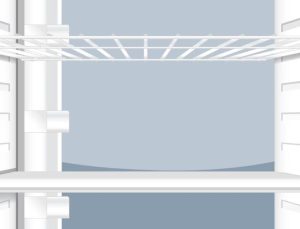
To ensure your Whole Wheat Bagels stay fresh and enjoyable, here are some storage tips and information about their shelf life
Storage
- Room Temperature: If you plan to consume the bagels within a day or two, you can store them at room temperature in an airtight container or a resealable plastic bag. Make sure they are fully cooled before sealing.
- Refrigeration: For longer storage, place the bagels in a plastic bag and keep them in the refrigerator. This can help prevent mold growth and keep them fresh for up to 5 days.
- Freezing: To extend their shelf life even further, consider freezing the bagels. Wrap each bagel individually in plastic wrap and then place them in a larger resealable bag. They can be stored in the freezer for up to 3 months.
Thawing and Reheating
- Thawing: When you’re ready to enjoy a frozen bagel, remove it from the freezer and let it thaw at room temperature or in the refrigerator.
- Reheating: To regain their freshness and texture, preheat your oven to 350°F (175°C). Place the thawed bagel directly on the oven rack or a baking sheet for about 5-7 minutes until warmed through. Alternatively, you can slice the bagel and lightly toast it in a toaster.
Shelf Life
The shelf life of Whole Wheat Bagels depends on the storage method:
- Room Temperature: Bagels stored at room temperature will have the best quality within 1-2 days. After that, they may start to dry out and become stale.
- Refrigeration: Refrigerated bagels can maintain their freshness for up to 5 days. After this point, they might lose some of their texture and flavor.
- Freezing: When properly stored in the freezer, bagels can last for up to 3 months. They may be safe to eat beyond this time, but the quality may deteriorate.
Remember that these are general guidelines, and factors such as humidity, temperature fluctuations, and individual bagel recipes can influence shelf life. Always use your judgment and consider the appearance, smell, and taste of the bagels before consuming them. If they appear moldy, have an off smell, or show signs of spoilage, it’s best to discard them.
Frequently Asked Questions

Q: What is a Poolish?
A: A Poolish is a pre-ferment used in baking that consists of equal parts flour and water along with a small amount of yeast. It enhances the flavor and texture of the final product.
Q: How does using a poolish help the bagels?
A: The poolish gives the bagels a lighter, airier texture and helps enhance the flavor of the whole wheat flour. It provides a more complex, tangy flavor.
Q: What is the ratio of poolish to flour in this recipe?
A: The recipe calls for 1 cup of poolish to 3 cups of flour in the final dough. This ratio gives enough lift without making the dough too wet.
Q: How long does the poolish need to ferment?
A: The poolish should ferment at room temperature for 8-12 hours before mixing the final dough. This allows the yeast to work and develop sourdough-like flavors.
Q: Can I make the poolish faster by using more yeast?
A: No, lengthening the fermentation time is key for flavor development. More yeast could make the poolish overly frothy.
Q: What kind of flour works best for the poolish and dough?
A: High protein bread flour or whole wheat flour give the best structure and rise. All-purpose flour can result in flatter bagels.
Q: Can I substitute the poolish for a biga or other pre-ferment?
A: Yes, you can experiment with bigas, levain, or sourdough starters in a 1:3 ratio. Just allow for the proper fermentation time.
Q: How long will a refrigerated poolish keep?
A: The poolish can be refrigerated up to 3 days before mixing into the final dough. Feed it with a bit more flour and water if needed.
Q: Can I use whole wheat flour exclusively?
A: While this recipe uses whole wheat flour, you can experiment with different ratios of whole wheat and all-purpose flour to achieve your desired level of whole wheat flavor and texture.
Q: How do I know when the dough is properly mixed?
A: The dough should be smooth and develop a slightly jagged texture. Mixing at medium to high speed helps create the desired consistency.
Q: What’s the purpose of the final fermentation?
A: The final fermentation is essential for proper texture and rise. Use a fermentation box with controlled temperature and humidity settings to ensure consistent results.
Q: Why do I need to boil the bagels before baking?
A: Boiling the bagels briefly before baking contributes to their chewy texture and shiny crust. It also helps set their shape and improves their overall appearance.
Q: Can I skip the step of rolling bagels in multi-grains?
A: Absolutely, this step is optional. Rolling the bagels in multi-grains before baking adds visual appeal and a unique texture, but you can skip it if you prefer a simpler bagel.
Q: How do I prevent bagels from sticking to the baking sheet?
A: Use parchment paper or lightly grease the baking sheet to prevent the bagels from sticking during baking.
Q: What’s the ideal baking temperature and time?
A: Preheat the oven to 220 degrees, then lower it to 210 degrees for baking. Bake the bagels for about 13 minutes until they achieve a beautiful golden-brown color.
Q: How do I know when the bagels are ready to be taken out of the oven?
A: Keep a close eye on the bagels while baking. A golden-brown color and a slightly firm exterior indicate that they’re ready to be removed from the oven.
TRY OUR OTHER BAGEL RECIPES?
Please find them from HERE
You might also be interested in below Recipes


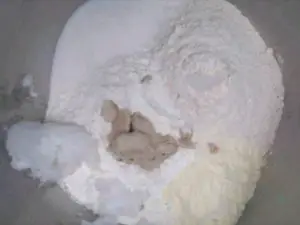 Step 1
Step 1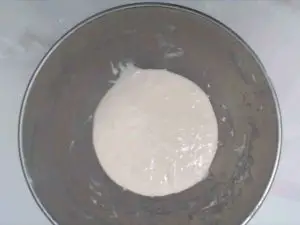 Step 2
Step 2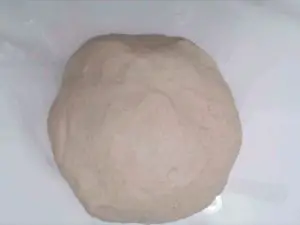 Step 3
Step 3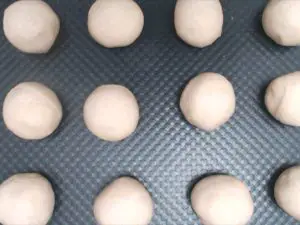 Step 4
Step 4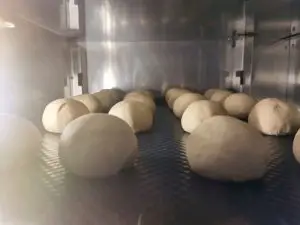 Step 5
Step 5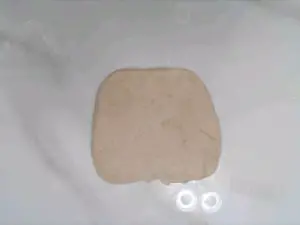 Step 6
Step 6 Step 7
Step 7 Step 8
Step 8 Step 9
Step 9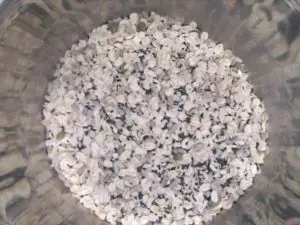 Step 10
Step 10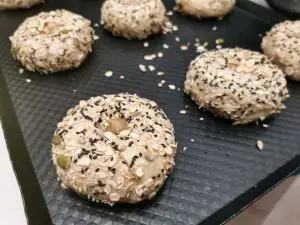 Step 11
Step 11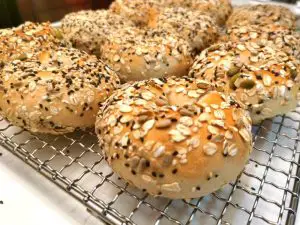 Step 12
Step 12